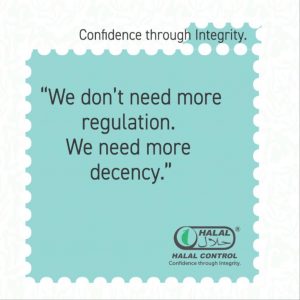 One of the top 100 thinkers in the world, Turkish born Nouriel Roubini, was at Dubai’s Global Islamic Economy Summit (GIES), and he stated, ‘…there is a need for a more resilient system, and that’s where there is potential for the Islamic system. It is less volatile and potentially more stable than conventional financial systems. The advanced economies can learn from the Islamic system in this respect…. The Halal economy is a real opportunity, but it needs to be more standardised and integrated into global markets.’
One of the top 100 thinkers in the world, Turkish born Nouriel Roubini, was at Dubai’s Global Islamic Economy Summit (GIES), and he stated, ‘…there is a need for a more resilient system, and that’s where there is potential for the Islamic system. It is less volatile and potentially more stable than conventional financial systems. The advanced economies can learn from the Islamic system in this respect…. The Halal economy is a real opportunity, but it needs to be more standardised and integrated into global markets.’
The last six weeks, from WIEF (UK) to GIES (Dubai) to WIBC (Bahrain) and this week’s Islamic Development Bank’s Roundtable in Malaysia, Opportunities & Challenges in Global Halal Industry/Economy Development, has raised the profile and importance of the $1.3 trillion Islamic finance, an ‘ethical’ financial lubricant, and $2.3 trillion Halal Industry, a real economy sector.
Now, with the 2014 WIEF to be held in Dubai, recipient of World Expo 2020, there is pressure on follow-up and follow-through on some of the ‘low-hanging’ deliverables tree.
Sizing & Seizing
According to 2103 State of the Global Islamic Economy report by Thomson Reuters, in collaboration with DinarStandard, its core sectors (below) are structurally impacted by Islamic values and driven by end user, retail and business, needs and demands:
-Food: $1.088 trillion expenditures (2012)
-Clothing: $224 billion
-Travel: $137 billion
-Media/Recreation: $151 billion
-Pharmaceuticals: $70 billion
-Cosmetics: $26 billion
-Islamic finance: $1.3 trillion
The non-Muslim/non-Islamic players dominate the Halal food sector, top 10 exporters are non-OIC countries and 85% of food supply chain is controlled by non-Muslims. The report will attract other such players looking to capture growth stories in today’s low growth environment of 2%.
Where are the Muslims and Muslim owned Halal producing companies? Will Muslims continue to play the role of ‘slaughtering and consuming’ FMCG manufactured/processed by non-Muslim companies?
Is the unrelenting focus on certification and accreditation of Halal (slaughter) by national bodies, which seem not to get along and others viewed as only money making, missing the boat by not including input from the consumer purchasing power?
Logos & Consumers
The data on the Halal life-style is not the story, only a minor component for getting us all on the same page. One story is about consumer inclusion in the work flow process, as it seems others, including some self-proclaimed industry bodies, are not giving them, people like me, options/choices.
For example, the focus is on the process and method of slaughtering: the animal is stunned, gassed or neither and then slaughtered either by hand or machinery with recitation of Almighty’s name, which may be recorded or live. We are not going to get to one Halal standard for a number of reasons, from cultural to school of Islamic thought.
Why not inform the market, the 1.8 billion Muslims, and let their $2.3 trillion decide! Today, brands, labels, logos, and ingredients tell a story of the company, values, processes, procurement, etc., it’s about information, transparency, accountability and responsibility. The more detailed the information results in an educated consumer choice.
Therefore, packages for lamb, beef, goat, chicken, etc., should have an easy to understand logo for gassing, stunning or neither and also show if hand or machine slaughtered. The consumer in the geography will decide what method of ‘Halal slaughter’ resonates with them and purchase accordingly.
[The decision on logo should not become an unending debate, again, focus groups and beta testing will allow for reflection, recognition and recall.]This is actual market intelligence backed by consumer purchasing power, hence, allowing companies to focus on what they do best for geographies, which is to manufacture/produce following rules of engagement.
Conclusion
Nouriel Roubini basically talked about halal-nomics, including standardization and integration, and halal-lifestyle is about stability, size, and growth, and now Muslims must seize the moment by their purchasing power!



